The city of San Cristóbal de las Casas used to be the capital of the state of Chiapas until 1892, but it is still considered the cultural centre of this Mexican federal state. I found myself here almost by accident and walked around the centre of the city for a very short period of time, late in the afternoon and in the early evening, but it was quite clear that this was an exceptionally beautiful city and that it is certainly worthy of a longer stay, but it was not meant to be for me this time.
Somehow it seems to me that in my case everything linked to San Cristóbal de las Casas was by accident and so, without any plan or intent, I simply came across the pedestrian street and started to stroll along it.
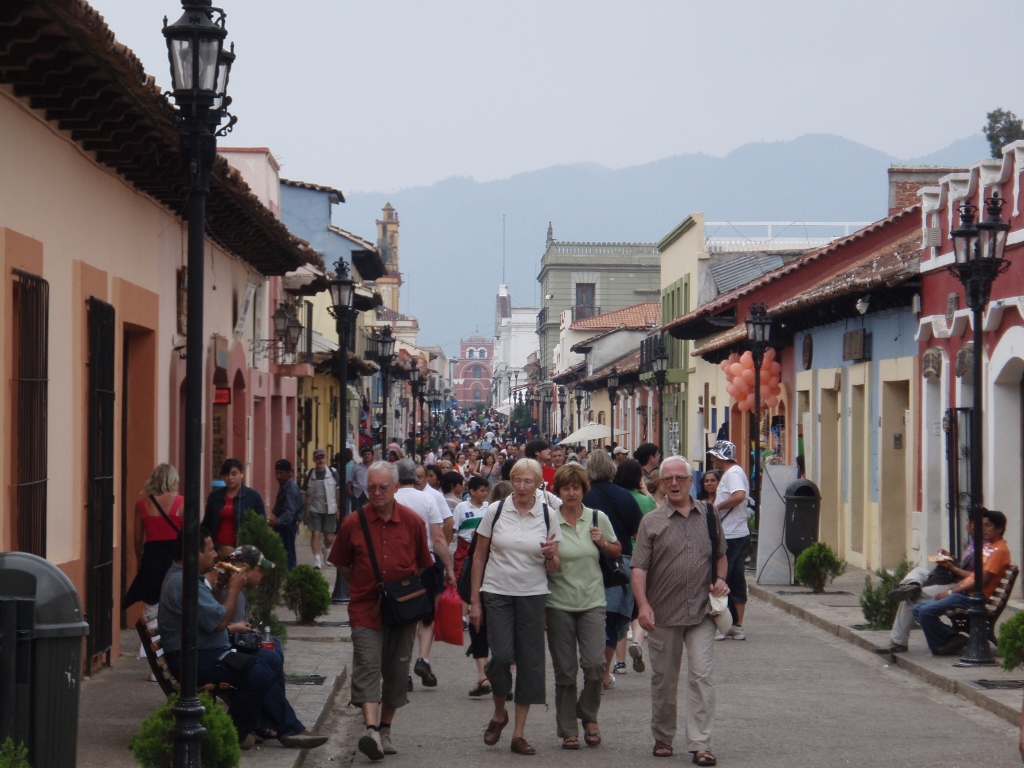 Pedestrian street in San Cristóbal de las Casas
Pedestrian street in San Cristóbal de las Casas
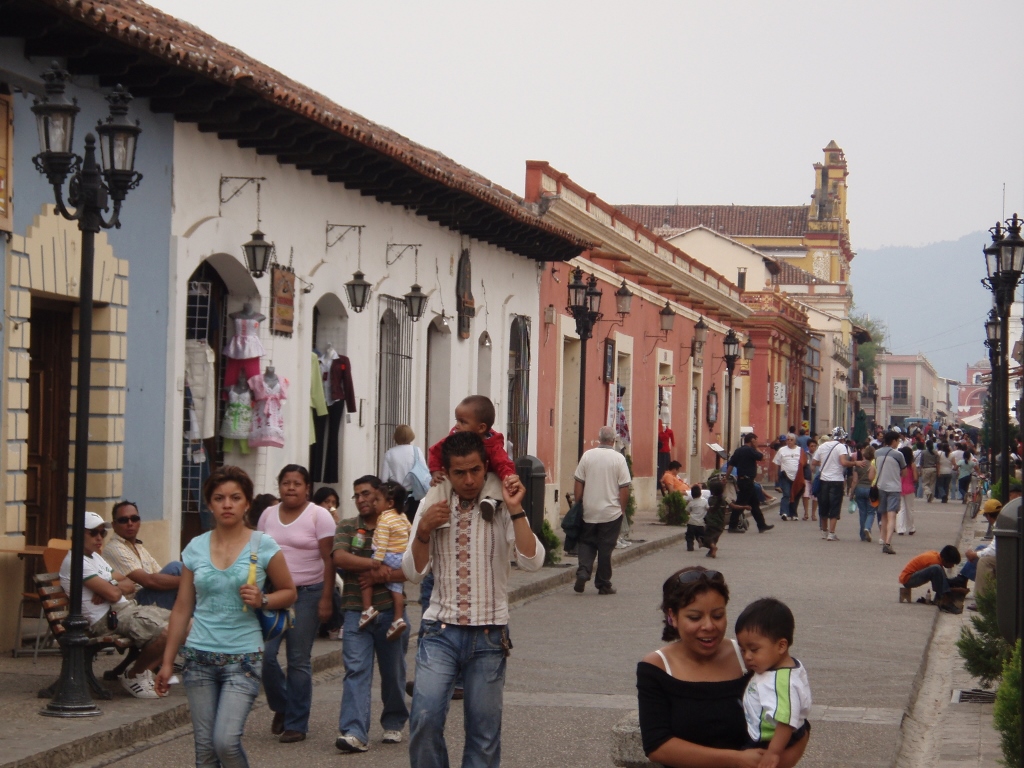 Pedestrian street in San Cristóbal de las Casas
Pedestrian street in San Cristóbal de las Casas
While walking along the pedestrian street in the centre of the city, I came across some information and then I bought a ticket to... theatre! I normally don’t do this during my travels, but I was still under the impression of the morning sightseeing of the archaeological site Palenque, while the performance dealt with the ancient Mayas, so I thought: “Why not?” In addition, the price of the ticket fitted into my daily budget, so I had a solution for the evening outing.
The walk brought me to the Peace Square (Plaza de la Paz) with the Cathedral. The first church was built in this place in 1528, then in the 17th century a new church was constructed in its place, while the richly decorated facade was completed in 1721.
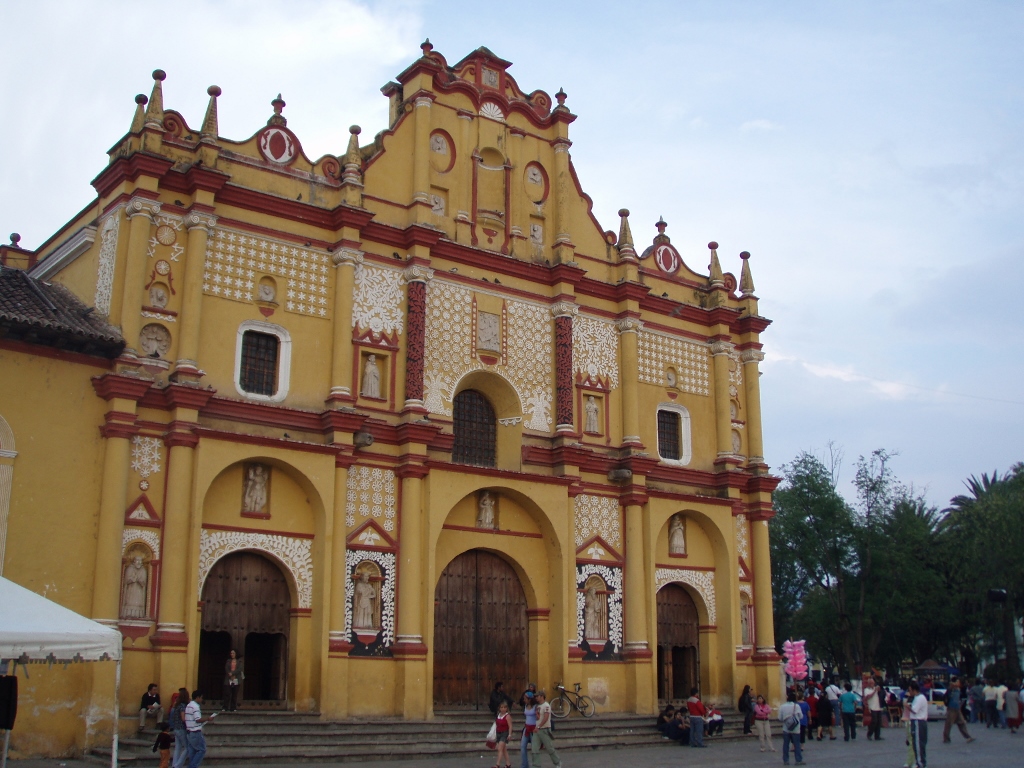 Cathedral
Cathedral
The Sun had already set and it was slowly getting dark, so I did not go into the Cathedral at all, for I wanted to look at the city and its inhabitants while there was still any light. It seemed to me that the old town-planners of San Cristóbal de las Casas definitively wanted to be original and so with its front facade the Cathedral faces a large paved plateau, while the main square with a park is located laterally from the Cathedral. That square space is called Plaza 31 de marzo or Zócalo. Generally speaking, Zócalo is a common name used for the main square in Mexican towns.
As I went towards the Zócalo, some people with numbers on their backs were running down the street that goes between the Cathedral and the main square and that was full of cars that moved very slowly on account of the large number of people in the street and I realised that some street run was ongoing. Admittedly, I was a little confused that these people ran between the slowly moving cars, but it seemed that nobody else was bothered with this. After all, everybody has the right to have their local customs.
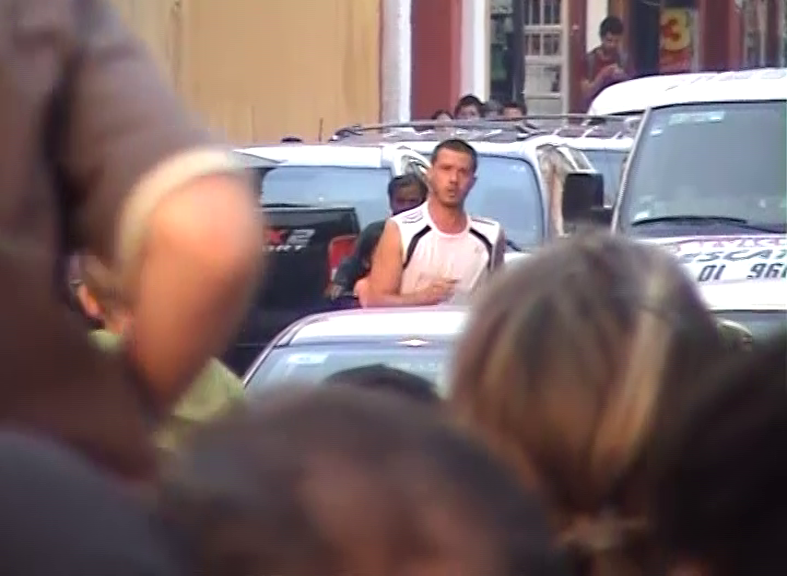 Competitors zigzagged around the vehicles
Competitors zigzagged around the vehicles
And so I got to the Zócalo and its park. Like in the other similar places it could be seen that a lot of local residents like to walk to these central squares with parks. It was very crowded, maybe because it was Sunday and maybe because there was a concert. The quality of my video recording is in line with the quality of the singer, but the video-clip certainly serves as a nice reminder of this evening.
After a short while spent listening to the local music, I went for a quick and light dinner and then I returned to the hotel in order to change for the theatre that is located in the pedestrian street.
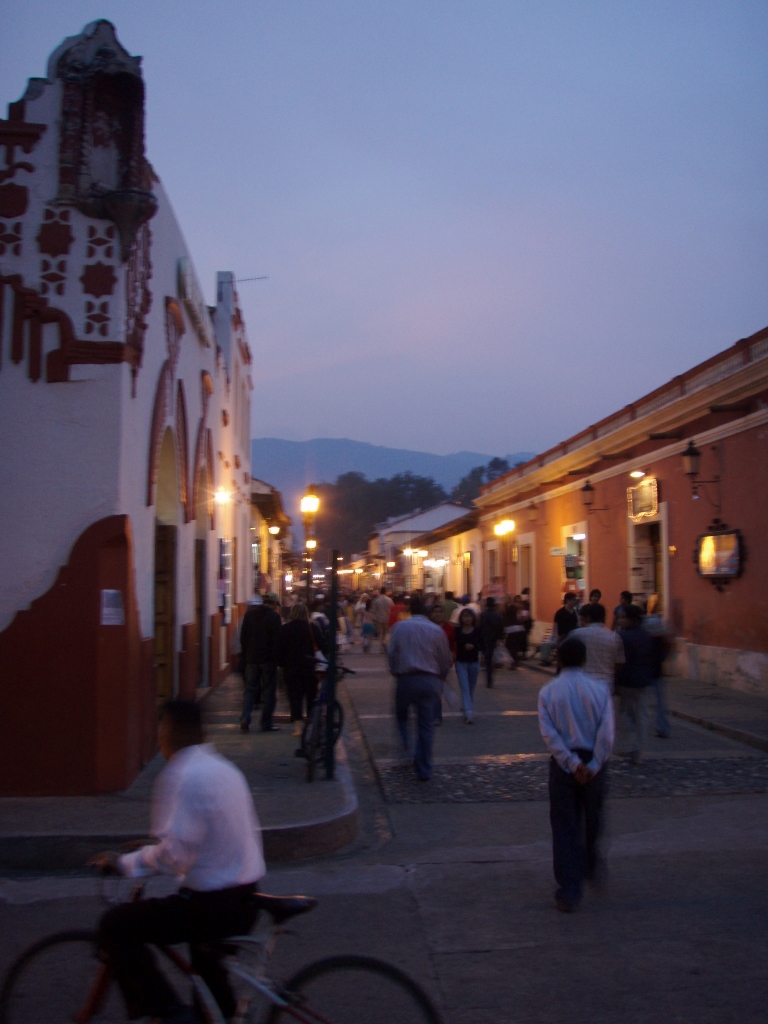 San Cristóbal de las Casas in the early evening
San Cristóbal de las Casas in the early evening
This was the Teatro Daniel Zebadúa. I came across information that says that this was the second theatre built in Chiapas region and also the first building in San Cristóbal for the construction of which in 1931 cement was used. The performance I watched was called “Red Palenque” and it was about some prince or king. Unfortunately, no photos or videos were permitted in the theatre. However, my main problem was that I was very sleepy because I had slept little and very poorly the night before. That’s why I was really glad when eventually I returned to my hotel and room where I went to sleep shortly thereafter. The following day was very important – I was leaving Mexico.
The next morning I got up before 7 am, got ready and went to the nearby coach terminal. My plan was to get to the town of Panajachel in Guatemala. But, this was not simple by any stretch of imagination. To start with, the coach from San Cristóbal de las Casas did not enter Guatemala at all. Moreover, as far as I could get it, there was no bus that went from here to Guatemala, so I had to change transportation and improvise.
And so I headed by coach for the town of Cuauhtémoc that is located very close to the border with Guatemala.
In the coach from San Cristóbal there was a smaller group of tourists sitting in front of me and their English-speaking guide explained to them what their travel to Panajachel would look like. At some point in Guatemala, they were to be picked up by a “normal” coach and it was expected that they would reach their destination around 6 pm.
Let me explain this with a “normal” coach. Namely, practically all the time while travelling around Mexico, I took good, modern coaches, comfortable and with air-conditioning, which are called “pulman” there. Once in Guatemala, such coaches are no longer used for ordinary passengers, but the public transportation is done by the so-called “chicken buses.” These are, by the rule, retired school buses from the USA, the yellow ones that the rest of the world sees in films. Some of them remain exactly the same as they are imported, while some are vamped up, but the size of the passenger cabin and the seats certainly remains the same. The reason why they are called the chicken buses (camioneta de pollos in Spanish) is that the local people often transport their domestic animals as well and chicken are probably the easiest to transport, which eventually gave the buses their nickname.
Since I also intended to get to Panajachel during the day, which would be before 7 pm, and since there was no “normal” coach waiting for me anywhere and I knew I would be taking chicken buses (I only didn’t have any idea what this would be like), I was starting to get overwhelmed by mild panic. I wondered if I was out of my mind for entering a country in which I did not know how I would get around, where the Mexican coaches would not even think of entering and I asked myself what I was doing in this part of the world at all, for if the Mexican coaches would not go there, who knew what “there” looked like. Southern Mexico is not very developed, there are often poor parts to be seen and yet, judging by the transportation and coaches/buses, Guatemala and the rest of the countries I was planning on visiting seemed “worse.” In other words, what was I doing there? That panic, the confused thoughts, the trepidation and anxiety, all of this led me to a desperate move – I asked the guide if I could “tag along” although I was fully aware that this was impossible. That girl was not in the least off-putting and unpleasant, but she was neither delighted with my question, so she just said that she would help me by asking around when we got to the final destination of the coach we were in. She also said that she doubted very much I could make it to Panajachel in one day using the local transportation. She believed the passing into Guatemala was problematic to start with, followed by the change of the buses, for it was becoming more and more apparent that I would have to change buses, although I still didn’t have any clear idea of what was ahead of me.
However, after this initial wave of panic, after I gave myself a subconscious advice: “Calm down, calm down” and read little more (yes, yes... now I FINALLY had a guidebook and this one was for the entire Central America), then I indeed calmed down a little. So, my goal for this day was the town of Panajachel on the shore of Lake Atitlán (Lago de Atitlán) in Guatemala, but I thought that I should simply move in that direction after all and if I could not get there in one day, then I would simply find some place to stay along the way.
When we got to Cuauhtémoc, that is, to a point outside the city, but close to the border crossing, I got my backpack and went to the migration office that was located there, they stamped my passport, I got back to the street where there were line taxis waiting for passengers to take them to the border itself.
As a reminder, here is a map of Mexico showing the route I followed during the first part of my stay in this country in 2008.
Since there were enough of us for a full car of the first line taxi in the queue, the local people and I – for already fully calm and valiant I left the group of tourists – started right away and soon we got to the border crossing which was some 3.5 km farther. Again I put my big backpack on, crossed the border on foot and immediately got to the Guatemalan migration authorities’ office. I got my passport stamp there and as soon as I got out I came across a place where I could exchange some money to have for the day. Also, I got into an auto rickshaw that took me up through a street lined on both sides by shops and stands selling all sorts of things to an unpaved parking lot where there was a whole bunch of chicken buses heading for different destinations and waiting for their passengers. As a reminder, the chicken buses are buses of a lower class that transport almost exclusively only the local population. Moreover, as it would turn out until the end of my journey, I haven’t met a single foreign visitor/tourist on any of the chicken buses I took and, by God, I did take a number of them.
Already during this first experience I realised that these buses maybe, not maybe but certainly, do not offer the same level of comfort of the large, modern coaches, but this does not make them any less good or less efficient as transportation. On the contrary!
As I was getting out of the auto rickshaw, an assistant driver of a chicken bus confirmed with me I was going to Huehue, short for Huehuetenango, took the big backpack off my back in order to pack it up properly, I got on the bus and 5 minutes later we were on the road.
Here is now a map that shows where I was moving around Guatemala during the first part of my stay in this country in 2008.
The chicken bus was smaller and less comfortable than the modern coaches (I am 1.80 m tall) and did not have air-conditioning, using the “open-window system” instead, which in my opinion meant that the temperature was significantly more pleasant than in the extremely cooled down coaches. However, what was important for me on this day was that the bus moved at quite a decent speed. Five or six months before this trip I was in India and the roads there were in a much worse state (full of potholes) than the one we were on, so everything actually seemed fine. Admittedly, this was a section of the Pan-American Highway, but what I want to say is that I was surprised, probably because I was frightened before crossing over to Guatemala and therefore I expected all the worst.
As for the temperature, the road runs through mountains here; moreover, Huehue is located at almost 2000 m above sea level. This means that despite this being the tropics, the temperatures were somewhat lower, i.e., more pleasant at higher altitudes, although the radiation of the Sun was still very strong.
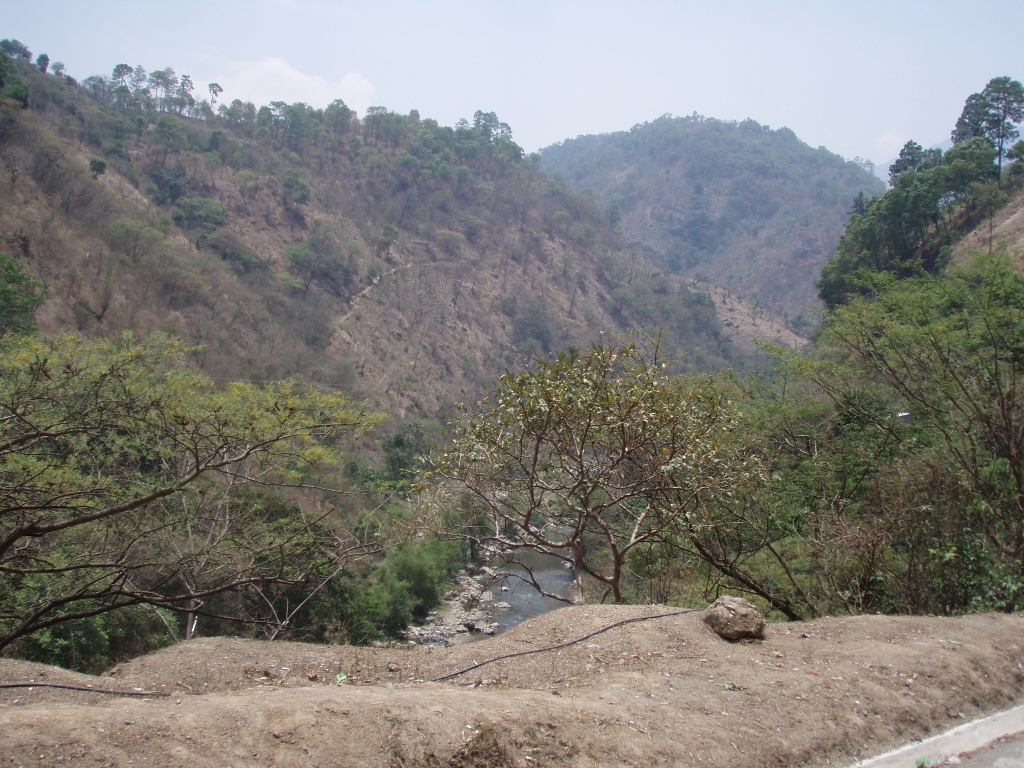 Landscapes in Guatemala
Landscapes in Guatemala
The next thing that was very important was that people were great. As I’ve mentioned, I stood out quite visibly from the rest of the passengers, not only because I was a foreigner, but also because I was significantly taller than almost all of them. One enters the bus without a ticket and the passenger just needs to find a free seat and then, after the bus has started to move, the conductor, i.e., the assistant driver (since he has several functions), goes through the bus and sells the tickets. In this way, my co-passengers realised I spoke Spanish.
This made them more relaxed and then they regularly, not only on this bus, but almost on all the buses I took, tried to make a contact. In the beginning they would just smile at me and then their curiosity would prevail and they would start talking with me. Thus, the man who on this occasion was sitting behind me, tapped me on the shoulder and asked me where I was from, what I was doing there, how come I was alone, etc. Very often I would be asked what my parents’ names were, but the essential thing was that they were all very much surprised that I travelled alone and they often asked me how come I was not afraid of travelling alone. I would usually just shrug my shoulders, saying I was careful, I did not go out in the evening and at night, and after all why anybody would want to cause me any harm anyway. At this last thing they looked at me disbelievingly and with eyes wide open, probably thinking that I was either enlightened or completely crazy.
But, perhaps the funniest question that several of them asked me on these bus drives was if Spanish was spoken in my country. What!? I was surprised at this question not because I thought they should know where my country was or which language was spoken there, but because my Spanish was not THAT good. However, I presume that this was because I don’t have a heavy American accent, which I suppose, being a linguist, happens regularly with visitors since most of them come from North America.
Another thing that was frequent on those chicken buses was that some people would enter the bus, drive in it for a while and use this time to sell different things, especially some alleged medicines and preparations.
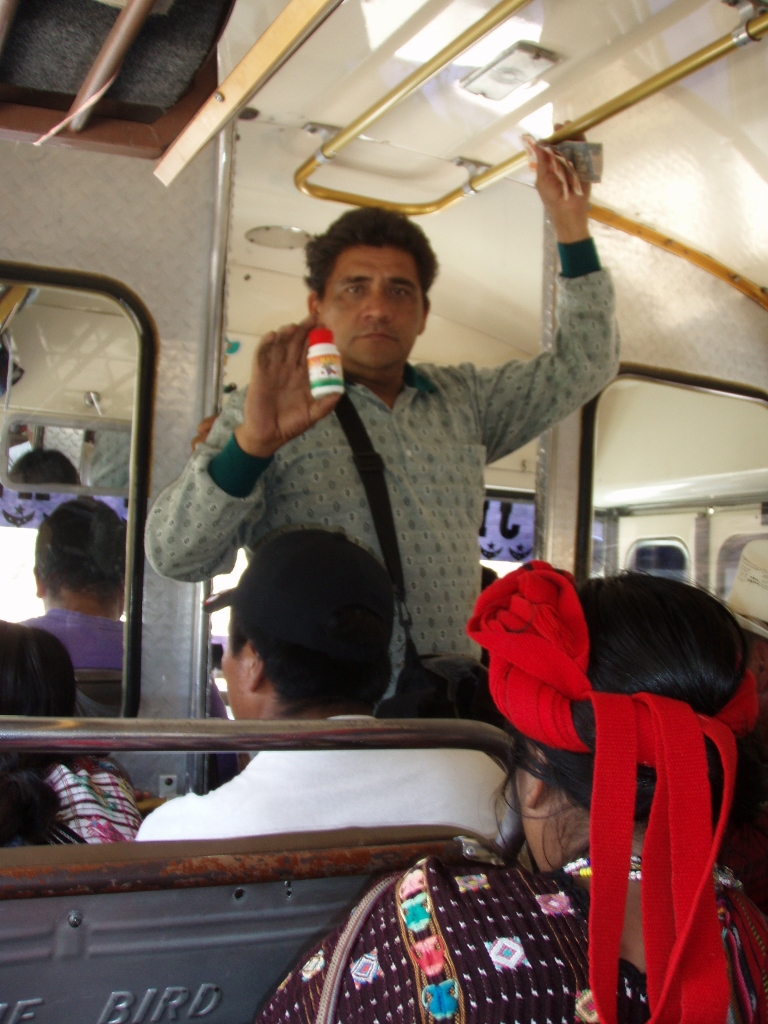 Sale of alleged medicinal preparations on a chicken bus
Sale of alleged medicinal preparations on a chicken bus
By the way, there was an elderly woman sitting in front of me and she had a beautifully hand-embroidered dress (this is not the one seen in the photo above) and I wanted to take a photo of this, but I didn’t want to cheat, so I asked for her permission. She agreed, but asked for a sum of money that maybe was not objectively very high, but it definitely exceeded the scope of my daily budget for miscellaneous expenses and therefore I made no photo.
I continued speaking with the man sitting next to me who also spoke some English. This chatting with co-passengers was also specifically important for me this time because in this way I collected information on how to get to Panajachel. All in all, a two-hour drive went by comparatively fast and I got to Huehue.
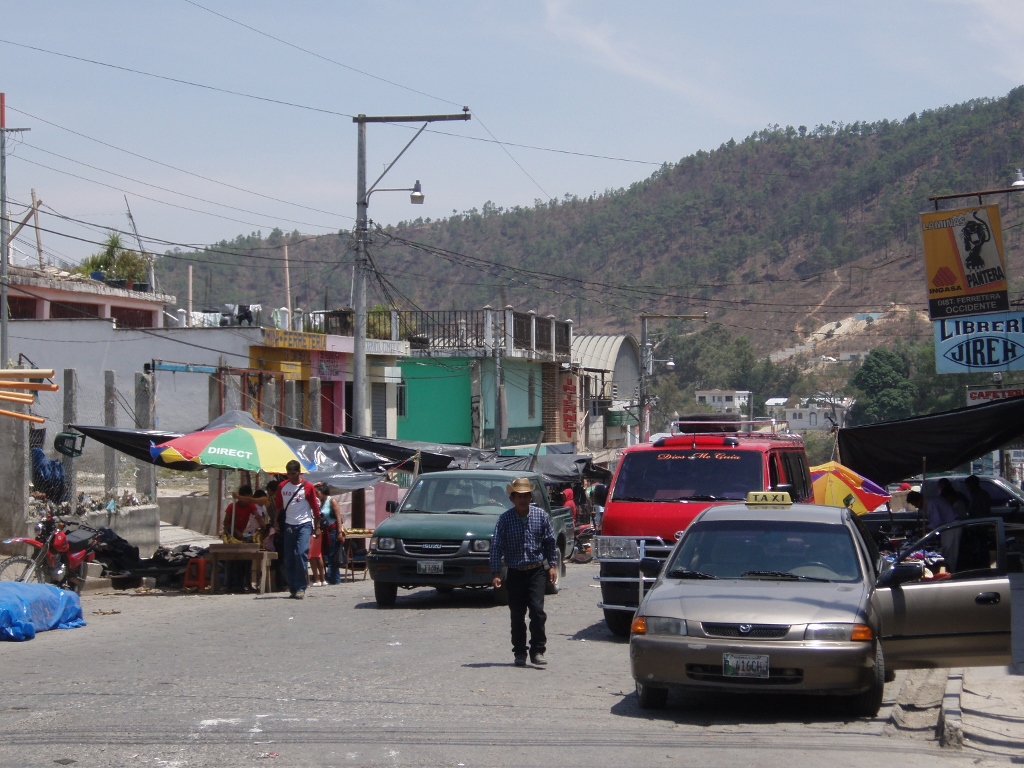 Street in Huehue, i.e., Huehuetanango
Street in Huehue, i.e., Huehuetanango